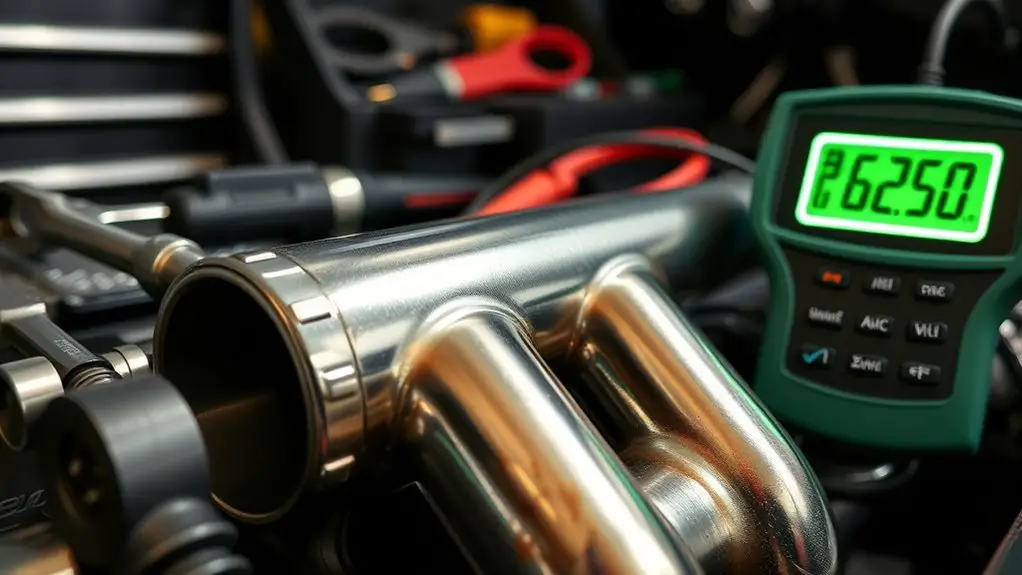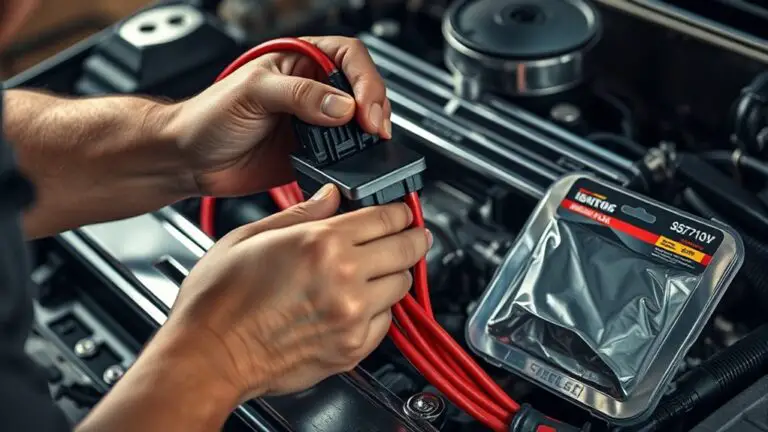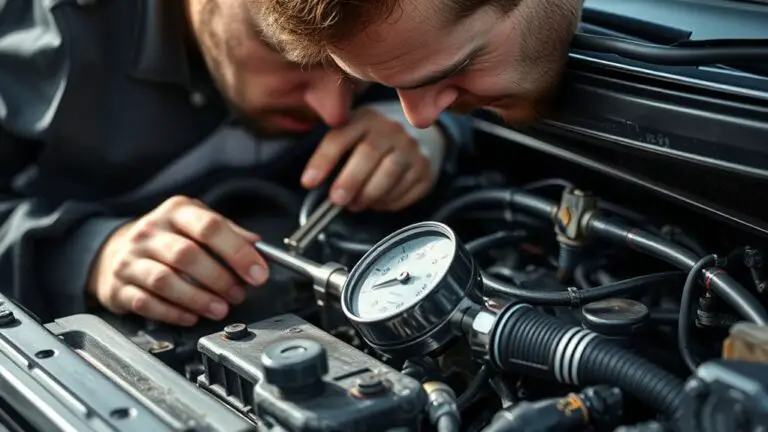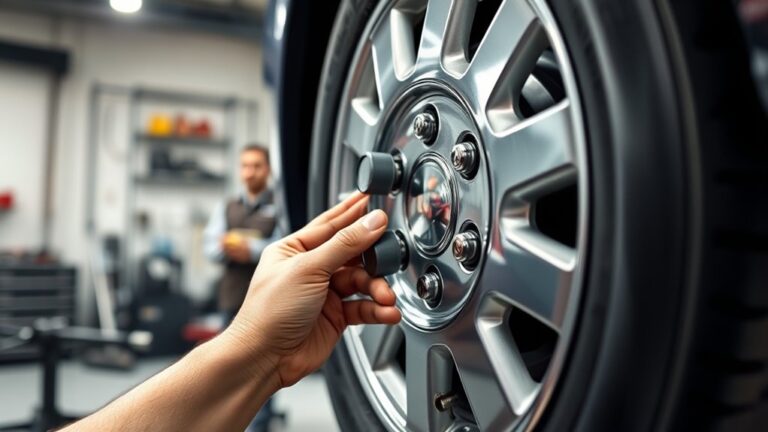How to Test a Exhaust Manifold Step-By-Step for Check Engine Light
To test the exhaust manifold for a check engine light, start by understanding its function and recognizing symptoms like strange noises or decreased performance. Gather tools such as a torque wrench and exhaust leak detection kit. Conduct a visual inspection for cracks or rust, then check for leaks using soapy water or a smoke test. Measure exhaust gas temperature and use a vacuum gauge to evaluate engine health. Further steps can reveal more about potential issues.
Understanding the Exhaust Manifold Function

The exhaust manifold plays an essential role in your vehicle’s engine system by channeling exhaust gases from the engine cylinders to the exhaust pipe. Its design greatly affects exhaust flow dynamics, ensuring ideal performance and efficiency. A well-engineered manifold minimizes back pressure, allowing gases to exit swiftly, which in turn enhances engine power.
When considering exhaust manifold design, factors like material composition and shape come into play. Cast iron and stainless steel are common materials, each offering distinct thermal properties and durability. The manifold’s configuration—whether tubular or log style—directly influences how gases travel, impacting overall engine responsiveness.
Understanding these elements enables you to appreciate how the exhaust manifold contributes to your vehicle’s freedom of movement. By optimizing exhaust flow dynamics, you’re not just improving performance; you’re also supporting the engine’s longevity. Recognizing this function is crucial for maintaining your vehicle’s health and efficiency.
Recognizing Symptoms of a Faulty Exhaust Manifold
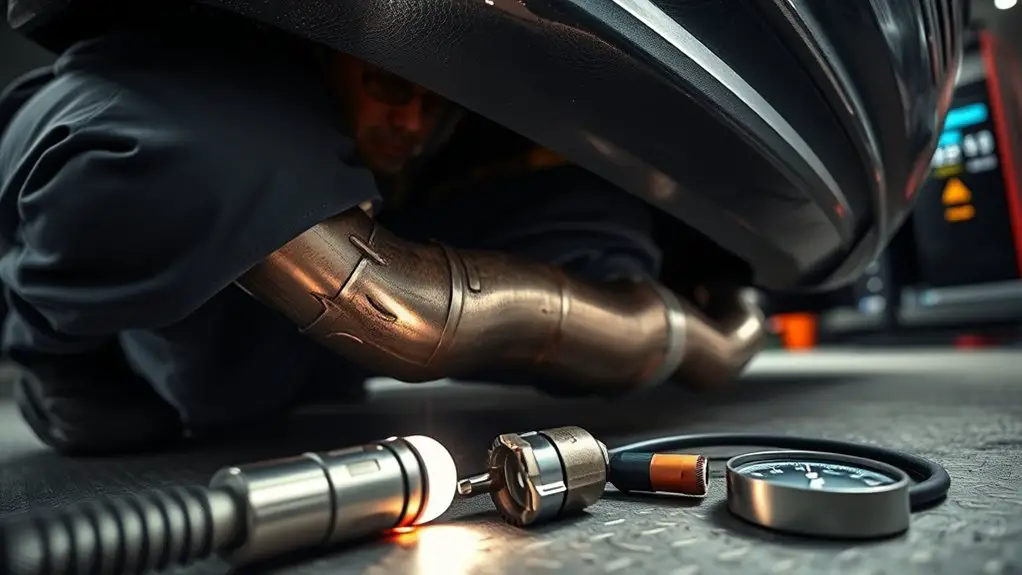
When your exhaust manifold is faulty, you’ll notice several distinct symptoms. You might hear unusual engine noises, experience decreased fuel efficiency, or even see visible exhaust leaks. Recognizing these signs is essential for timely repairs and maintaining your vehicle’s performance.
Unusual Engine Noises
Although engine noises can stem from various issues, unusual sounds often indicate a problem with the exhaust manifold. If you hear a hissing or popping noise, it’s likely due to exhaust leaks, which can cause engine vibration and affect performance. Pay attention to the sound frequency as well; a higher pitch may suggest a crack in the manifold, while a low rumble could indicate a more significant problem. Additionally, if you notice changes in the sound when accelerating or decelerating, these fluctuations may further signal a malfunction. By recognizing these symptoms early, you can address the issue before it leads to more extensive repairs, ensuring your vehicle maintains its freedom on the road.
Decreased Fuel Efficiency
Unusual engine noises can be a precursor to more significant issues, including decreased fuel efficiency. If you notice your vehicle consuming more fuel than usual, it’s time to investigate the exhaust manifold. A faulty manifold can disrupt the fuel system, leading to improper air-fuel mixture and reduced engine performance. You might experience a drop in mileage or increased emissions, indicating that the exhaust gases aren’t flowing as they should. Monitor your fuel consumption closely; a sudden change can signify manifold problems. Additionally, keep an eye on engine power; sluggish performance can stem from inefficient exhaust flow. Addressing these symptoms early can help restore peak fuel efficiency and guarantee your engine runs smoothly.
Visible Exhaust Leaks
If you notice visible exhaust leaks, it’s crucial to address them promptly, as they can signal a failing exhaust manifold. Look for exhaust leak signs like hissing or popping noises, along with soot or discoloration around the manifold area. These indicators often mean hot gases are escaping, which can lead to further engine damage if left unchecked.
To confirm the leak, inspect the manifold and associated gaskets for cracks or gaps. Utilizing a smoke test or listening for unusual sounds can help pinpoint the source. Once identified, consider your repair options carefully: you might need to replace gaskets, repair cracks, or even replace the entire manifold. Address these issues swiftly to maintain engine performance and efficiency.
Gathering Necessary Tools and Equipment

To effectively test an exhaust manifold, you’ll need a specific set of tools and equipment. Proper tool selection is vital for accuracy and efficiency, so make certain to gather the following items before you begin. Additionally, always prioritize safety precautions to protect yourself during the testing process.
- Torque wrench: Guarantees accurate tightening of bolts to manufacturer specifications.
- Exhaust leak detection kit: Helps identify any leaks effectively.
- Safety goggles and gloves: Protects your eyes and hands from debris and hot surfaces.
- Flashlight or inspection mirror: Aids in examining hard-to-reach areas.
Having these tools on hand will streamline your testing process and help you diagnose any issues with the exhaust manifold. Remember, being prepared not only saves time but also enhances your overall testing experience.
Conducting a Visual Inspection
While you prepare to assess the exhaust manifold, conducting a thorough visual inspection is essential for identifying any apparent issues. Start by examining the exhaust manifold materials; whether it’s cast iron, stainless steel, or aluminum, each can exhibit different wear patterns. Look for cracks, warping, or corrosion, which are common manifold issues that can lead to performance problems. Inspect the mounting points for any signs of loosening or damage, as this can affect the seal and lead to exhaust leaks. Additionally, check the heat shields for any signs of deterioration or excessive rust, which may indicate overheating. Don’t forget to look for any discoloration, as this can signal overheating or improper installation. By meticulously evaluating these factors, you’ll gain valuable insights into the condition of your exhaust manifold and the potential need for further investigation or repair.
Checking for Exhaust Leaks
After completing the visual inspection, it’s important to check for exhaust leaks, as these can greatly impact engine performance and efficiency. Effective leak detection is essential for your vehicle’s health. Here are some methods you can use:
- Soapy Water Test: Apply a soapy solution to suspected areas. Bubbles will indicate a leak.
- Smoke Test: Introduce smoke into the exhaust system; watch for escaping smoke, signaling a leak.
- Listening: With the engine running, listen for hissing or popping sounds around the manifold, which may indicate an exhaust leak.
- Pressure Test: Use a pressure gauge to measure exhaust pressure; an abnormal reading may point to a leak.
Once you identify any leaks, consider appropriate repair methods, such as replacing gaskets or tightening connections. Addressing exhaust leaks promptly can enhance your engine’s efficiency and longevity.
Testing Manifold Gasket Integrity
To guarantee the integrity of the manifold gasket, you’ll need to employ several testing techniques. Start with a thorough visual inspection to identify any obvious signs of wear or damage. Then, move on to smoke testing and sound detection methods to pinpoint any potential leaks that may compromise performance.
Visual Inspection Techniques
A thorough visual inspection is vital for evaluating the integrity of the manifold gasket. You’ll want to check for signs of wear or damage, especially if you’ve made any performance upgrades. Use the following techniques to guide your inspection:
- Inspect for Cracks: Look closely at the exhaust manifold materials for any visible cracks or signs of fatigue.
- Check for Carbon Deposits: Accumulations can indicate leaks or improper sealing.
- Examine the Gasket Surface: Confirm there’s no warping or deterioration of the gasket.
- Look for Fluid Leaks: Any signs of oil or coolant leaks around the manifold area should raise concern.
Smoke Test Procedure
Following your visual inspection, conducting a smoke test can provide further confirmation of the manifold gasket’s integrity. This method helps identify any exhaust leaks that might not be visible to the naked eye. Here’s a step-by-step guide for your smoke test:
| Step | Action | Purpose |
|---|---|---|
| 1 | Seal the exhaust system | Prevents smoke from escaping |
| 2 | Introduce smoke into system | Reveals leaks through visible smoke |
| 3 | Inspect for smoke emissions | Locate the source of exhaust leaks |
| 4 | Replace gasket if leaks found | Guarantee proper manifold function |
Sound Detection Methods
While visual inspections and smoke tests are effective, utilizing sound detection methods can also be invaluable in evaluating the integrity of the manifold gasket. By employing sound intensity measurements and frequency analysis, you can identify leaks that may not be visible. Here’s how to approach it:
- Use a sensitive microphone to capture sound levels around the manifold.
- Analyze sound frequencies to pinpoint unusual noises, indicating potential leaks.
- Compare baseline sound levels with those during engine operation.
- Document any irregular sound patterns and correlate them with engine performance.
Through these methods, you’ll gain a deeper understanding of the manifold’s condition, allowing for timely repairs and ensuring peak engine performance.
Measuring Exhaust Gas Temperature
Measuring exhaust gas temperature is essential for diagnosing issues within the exhaust manifold and optimizing engine performance. Accurate exhaust temperature readings can help identify problems like leaks or inefficient combustion. Here are some effective measurement techniques you can employ:
| Technique | Description |
|---|---|
| Thermocouple | A sensor that measures temperature via electrical resistance changes. |
| Infrared Thermometer | Non-contact method using infrared radiation to gauge surface temperature. |
| K-Type Thermocouple | Ideal for high-temperature environments, usually inserted in the exhaust flow. |
| Data Logger | Records temperature over time for thorough analysis. |
| Scan Tool | Digital tool that retrieves temperature data from the vehicle’s ECU. |
Using a Vacuum Gauge for Diagnosis
When diagnosing an exhaust manifold, a vacuum gauge is an essential tool for evaluating system performance. You’ll want to read the gauge values carefully, as they provide critical insights into the engine’s health. Accurately interpreting these results can help you pinpoint issues such as leaks or blockages.
Purpose of Vacuum Gauge
A vacuum gauge is an essential tool for diagnosing issues with an exhaust manifold and overall engine performance. Understanding vacuum gauge basics helps you identify potential problems effectively. The gauge measures vacuum levels within the intake manifold, providing insight into engine health and efficiency. Key vacuum gauge applications include:
- Detecting leaks in the exhaust manifold or intake system.
- Assessing engine wear, such as valve or piston ring issues.
- Monitoring fuel mixture, indicating whether the engine runs too rich or lean.
- Evaluating overall performance, highlighting irregularities in engine function.
Reading Gauge Values
Reading gauge values from a vacuum gauge is essential for diagnosing issues related to the exhaust manifold. Start by ensuring your gauge calibration is accurate; an improperly calibrated gauge can lead to misleading readings. Connect the vacuum gauge to a suitable intake manifold port and observe the needle’s movement. Steady readings indicate normal operation, while fluctuations may suggest problems like leaks, blockages, or valve issues. During data interpretation, pay attention to the specific vacuum values; for instance, a low reading could signify a leak or an exhaust restriction. Always take multiple readings to confirm consistency. This methodical approach helps you pinpoint potential faults in the exhaust manifold system, allowing for effective troubleshooting and repairs.
Interpreting Results Accurately
How can you guarantee accurate interpretation of vacuum gauge results in diagnosing exhaust manifold issues? Start by understanding the relationship between manifold materials and thermal expansion. Variations in these factors can affect your readings. Here’s how to interpret your results effectively:
- Consistent Readings: Confirm your vacuum gauge shows stable values to validate system integrity.
- Low Readings: A consistently low reading may indicate leaks or issues with manifold materials.
- Fluctuating Readings: These can suggest problems with the engine’s timing or air-fuel mixture.
- High Readings: An excessively high reading might point to a blockage or restriction.
Inspecting for Cracks and Damage
While inspecting the exhaust manifold, it’s essential to look for cracks and other forms of damage that could lead to performance issues. Manifold materials, such as cast iron or stainless steel, are chosen for their heat resistance, but they can still develop cracks over time. Use a flashlight to check for visible fractures, paying close attention to weld seams and mounting points where stress is concentrated.
| Type of Damage | Impact on Performance |
|---|---|
| Hairline Cracks | Can cause exhaust leaks |
| Large Cracks | May lead to significant power loss |
| Warping | Affects sealing and fitment |
| Corrosion | Weakens structural integrity |
If you find any damage, it’s vital to address it promptly to prevent further issues. Regular inspections will help maintain your vehicle’s performance and longevity.
Seeking Professional Help if Needed
If you encounter significant damage during your inspection, it’s essential to seek professional help to secure accurate diagnosis and repair. A qualified mechanic can provide insights that might not be apparent to the untrained eye. Here’s what you should consider when seeking assistance:
- Professional diagnostics: Advanced tools can pinpoint issues that manual checks may miss.
- Mechanic consultation: A detailed discussion with a mechanic can provide clarity on the extent of the damage.
- Repair options: Professionals can offer various solutions tailored to your vehicle’s needs.
- Warranty considerations: Confirming repairs are done by certified technicians can protect any warranties.
Don’t hesitate to reach out for expert help if needed. Addressing exhaust manifold issues promptly can prevent further complications and keep your vehicle running smoothly. Being proactive about repairs not only enhances performance but also secures your safety on the road.
Frequently Asked Questions
How Often Should I Check My Exhaust Manifold?
You should check your exhaust manifold at least once a year as part of your routine vehicle maintenance. Regular exhaust inspection frequency helps catch issues early, preventing costly repairs. Pay attention to signs like unusual noises or exhaust leaks. For manifold maintenance tips, guarantee proper heat shielding and check for cracks or corrosion during inspections. Staying proactive will help you maintain your vehicle’s performance and keep your driving experience enjoyable and stress-free.
Can a Faulty Exhaust Manifold Affect Fuel Efficiency?
Yes, a faulty exhaust manifold can greatly affect fuel efficiency. When exhaust leaks occur, it disrupts the proper balance of air and fuel in the combustion process, leading to inefficient fuel consumption. As the engine works harder to compensate, you’ll notice a decline in mileage. Regular inspections can help detect these leaks early, allowing you to maintain peak performance and enjoy the freedom of driving without constant fuel worries.
What Causes an Exhaust Manifold to Fail?
You know, it’s a real bummer when your exhaust manifold goes kaput. Common causes of failure include exhaust leaks and manifold cracks, often due to thermal stress or corrosion. Over time, the heat cycles can weaken the metal, leading to those pesky cracks. Additionally, improper installation or using low-quality materials can exacerbate the issue. Keeping an eye on these factors can help you avoid costly repairs down the road.
Is It Safe to Drive With a Damaged Exhaust Manifold?
No, it’s not safe to drive with a damaged exhaust manifold. Exhaust leaks can lead to decreased engine performance and increased emissions, which can harm both your vehicle and the environment. Additionally, the fumes escaping can pose serious health risks, including carbon monoxide exposure. If you notice any signs of damage, it’s best to address the issue promptly to guarantee your safety and maintain your vehicle’s efficiency. Don’t take unnecessary risks with your health or your ride.
How Much Does It Cost to Replace an Exhaust Manifold?
Replacing an exhaust manifold can cost you anywhere from $300 to $1,500, depending on the type. For cast iron or stainless steel, prices vary; the latter often comes with a higher price tag. The replacement process involves removing the old manifold and carefully installing the new one, ensuring all seals are tight. While it’s a labor-intensive job, investing in quality parts can give your vehicle the freedom to breathe easier on the road.

